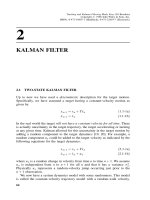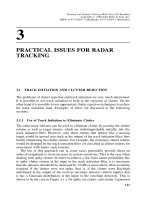ECG made easy
Bạn đang xem bản rút gọn của tài liệu. Xem và tải ngay bản đầy đủ của tài liệu tại đây (4.23 MB, 252 trang )
ECG Made Easy
ECG Made Easy
Fourth Edition
Atul Luthra
MBBS MD DNB
Diplomate
National Board of Medicine
Physician and Cardiologist
Delhi, India
www.atulluthra.in
®
JAYPEE BROTHERS MEDICAL
PUBLISHERS (P) LTD
New Delhi • Panama City • London
®
Jaypee Brothers Medical Publishers (P) Ltd.
Headquarter
Jaypee Brothers Medical Publishers (P) Ltd
4838/24, Ansari Road, Daryaganj
New Delhi 110 002, India
Phone: +91-11-43574357
Fax: +91-11-43574314
Email:
Overseas Offices
J.P. Medical Ltd.,
83 Victoria Street London
SW1H 0HW (UK)
Phone: +44-2031708910
Fax: +02-03-0086180
Email:
Jaypee-Highlights Medical Publishers Inc.
City of Knowledge, Bld. 237, Clayton
Panama City, Panama
Phone: 507-317-0160
Fax: +50-73-010499
Email:
Website: www.jaypeebrothers.com
Website: www.jaypeedigital.com
© 2012, Jaypee Brothers Medical Publishers
All rights reserved. No part of this book may be reproduced in any form or by any means
without the prior permission of the publisher.
Inquiries for bulk sales may be solicited at:
This book has been published in good faith that the contents provided by the author contained
herein are original, and is intended for educational purposes only. While every effort is made
to ensure accuracy of information, the publisher and the author specifically disclaim any
damage, liability, or loss incurred, directly or indirectly, from the use or application of any of
the contents of this work. If not specifically stated, all figures and tables are courtesy of the
author. Where appropriate, the readers should consult with a specialist or contact the
manufacturer of the drug or device.
ECG Made Easy®
First Edition : 1998
Second Edition : 2004
Third Edition : 2007
Fourth Edition : 2012
ISBN 978-93-5025-591-9
Printed at
To
My Parents
Ms Prem Luthra
and
Mr Prem Luthra
Who guide and bless me
from heaven
PREFACE
The imaging techniques of contemporary ‘high-tech’ cardiology
have failed to eclipse the primacy of the 12-lead ECG in the
initial evaluation of heart disease. This simple, cost-effective
and readily available diagnostic modality continues to intrigue
and baffle the clinician as much as it confuses the student. A
colossal volume of literature on understanding ECG bears
testimony to this fact.
This book is yet another humble attempt to bring the subject
of ECG closer to the hearts of students and clinicians in a
simple and concise form. As the chapters unfold, the subject
gradually evolves from basics to therapeutics. Although
emphasis is on ECG diagnosis, causation of abnormalities and
their clinical relevance are briefly mentioned too. This should
help students preparing for their examinations without having to
search through voluminous textbooks.
While some arrhythmias are harmless, others are ominous
and life-threatening. The clinical challenge lies in knowing the
cause of an arrhythmia, its significance, differential diagnosis
and practical aspects of management. Therefore, seemingly
similar cardiac rhythms are discussed together under individual
chapter headings. Medical students, resident doctors, nurses
and technicians will find this format particularly useful.
I have thoroughly enjoyed the experience of writing this
book and found teaching as pleasurable as learning. Since the
scope for further refinement always remains, it is a privilege to
bring out the vastly improved 4th edition of ECG Made Easy.
Your appreciation, comments and criticisms are bound to spur
me on even further.
Atul Luthra
ACKNOWLEDGMENTS
I am extremely grateful to:
•
My school teachers who helped me to acquire good
command over the English language.
•
My professors at medical college who taught me the science
and art of clinical medicine.
•
My heart patients whose cardiograms stimulated my grey
matter to make me wiser.
•
Authors of books on electrocardiography to which I referred
liberally, while preparing the manuscript.
•
My readers whose generous appreciation, candid comments
and constructive criticism spur me on.
•
M/s Jaypee Brothers Medical Publishers (P) Ltd who repose
their unflinching faith in me and provide moral encouragement along with expert editorial assistance.
CONTENTS
1. Nomenclature of ECG Deflections
The
The
The
The
The
2. Electrocardiographic Leads
The
The
The
The
The
1
Electrocardiogram 1
Electrophysiology 5
Deflections 9
Intervals 12
Segments 13
15
Electrocardiographic Leads 15
Limb Leads 15
Chest Leads 19
Lead Orientation 20
Einthoven Triangle 21
3. ECG Grid and Normal Values
23
The ECG Grid 23
The Normal ECG Values 24
4. Determination of Electrical Axis
33
The Electrical Axis 33
The Hexaxial System 33
The QRS Axis 34
Determination of QRS Axis 36
Abnormalities of QRS Axis 38
5. Determination of the Heart Rate
The Heart Rate 40
The Heart Rhythm 43
40
xii
ECG Made Easy
6. Abnormalities of the P Wave
53
Normal P Wave 53
Absent P Wave 53
Inverted P Wave 54
Changing P Wave Morphology 54
Tall P Wave 55
Broad P Wave 56
7. Abnormalities of QRS Complex
59
Normal QRS Complex 59
Low-Voltage QRS Complex 60
Alternating QRS Voltage 61
Abnormal QRS Axis 62
Fascicular Block or Hemiblock 65
Non-Progression of R Wave 67
Abnormal Q Waves 69
Abnormally Tall R Waves 71
Abnormally Deep S Waves 77
Abnormally Wide QRS Complexes 78
8. Abnormalities of the T Wave
87
Normal T Wave 87
Inverted T Wave 87
Tall T Wave 96
9. Abnormalities of the U Wave
100
Normal U Wave 100
Prominent U Wave 100
Inverted U Wave 101
10. Abnormalities of P-R Segment
103
P-R Segment Depression 103
11. Abnormalities of S-T Segment
105
S-T Segment Depression 105
S-T Segment Elevation 111
12. Abnormalities of P-R Interval
Normal P-R Interval 118
Prolonged P-R Interval 119
Shortened P-R Interval 120
118
Contents xiii
13. Abnormalities of Q-T Interval
124
Normal Q-T Interval 124
Shortened Q-T Interval 125
Prolonged Q-T Interval 126
14. Premature Beats in Regular Rhythm
129
Premature Beats 129
Atrial Premature Complex 129
Junctional Premature Complex 131
Ventricular Premature Complex 131
15. Pauses During Regular Rhythm
142
Pauses During Rhythm 142
Pause After Premature Beat 142
Pause After Blocked Premature Beat 143
Pause Due to Sinoatrial Block 143
Pause Due to Atrioventricular Block 145
16. Fast Regular Rhythm with Narrow QRS
153
Regular Fast Rhythm 153
Sinus Tachycardia 153
Atrial Tachycardia 154
Atrial Flutter 158
17. Normal Regular Rhythm with Narrow QRS
168
Regular Normal Rhythm 168
Normal Sinus Rhythm 168
Atrial Tachycardia with 2:1 A-V Block 168
Atrial Flutter with 4:1 A-V Block 169
Junctional Tachycardia 169
18. Fast Irregular Rhythm with Narrow QRS
Irregular Fast Rhythm 174
Atrial Tachycardia with A-V Block 174
Atrial Flutter with Varying A-V Block 175
Multifocal Atrial Tachycardia 175
Atrial Fibrillation 176
174
xiv ECG Made Easy
19. Fast Regular Rhythm with Wide QRS
184
Fast Wide QRS Rhythm 184
Ventricular Tachycardia 184
Supraventricular Tachycardia with Aberrant
Ventricular Conduction 187
Supraventricular Tachycardia with Pre-existing
QRS Abnormality 188
20. Normal Regular Rhythm with Wide QRS
195
Normal Wide QRS Rhythm 195
Accelerated Idioventricular Rhythm 195
21. Fast Irregular Rhythm with Bizarre QRS
199
Irregular Wide QRS Rhythm 199
Ventricular Flutter 199
Ventricular Fibrillation 200
22. Slow Regular Rhythm with Narrow QRS
206
Regular Slow Rhythm 206
Sinus Bradycardia 207
Junctional Escape Rhythm 208
Sinus Rhythm with 2:1 S-A Block 209
Sinus Rhythm with 2:1 A-V Block 210
Blocked Atrial Ectopics in Bigeminy 210
23. Slow Irregular Rhythm with Narrow QRS
214
Irregular Slow Rhythm 214
Sinus Arrhythmia 214
Wandering Pacemaker Rhythm 215
Sinus Rhythm with Varying S-A Block 216
Sinus Rhythm with Varying A-V Block 217
24. Slow Regular Rhythm with Wide QRS
220
Slow Wide QRS Rhythm 220
Complete A-V Block 220
Complete S-A Block 222
External Pacemaker Rhythm 223
Slow Rhythm with Existing Wide QRS 224
Index
231
Nomenclature of ECG Deflections 1
1
Nomenclature of
ECG Deflections
THE ELECTROCARDIOGRAM
The electrocardiogram (ECG) provides a graphic depiction of
the electrical forces generated by the heart. The ECG graph
appears as a series of deflections and waves produced by
each cardiac cycle.
Before going on to the genesis of individual deflections and
their terminology, it would be worthwhile mentioning certain
important facts about the direction and magnitude of ECG
waves and the activation pattern of myocardium.
Direction
By convention, a deflection above the baseline or isoelectric
(neutral) line is a positive deflection while one below the
isoelectric line is a negative deflection (Fig. 1.1A).
The direction of a deflection depends upon two factors
namely, the direction of spread of the electrical force and
the location of the recording electrode.
In other words, an electrical impulse moving towards an
electrode creates a positive deflection while an impulse
moving away from an electrode creates a negative deflection
(Fig. 1.1B). Let us see this example.
We know that the sequence of electrical activation is such
that the interventricular septum is first activated from left to
right followed by activation of the left ventricular free wall
from the endocardial to epicardial surface.
2
ECG Made Easy
Fig. 1.1A: Direction of the deflection on ECG:
A. Above the baseline: positive deflection
B. Below the baseline: negative deflection
Fig. 1.1B: Effect of current direction on polarity of deflection:
A. Towards the electrode—upright deflection
B. Away from electrode—inverted deflection
If an electrode is placed over the right ventricle, it records
an initial positive deflection representing septal activation
towards it, followed by a major negative deflection that
denotes free wall activation away from it (Fig. 1.2).
If, however, the electrode is placed over the left ventricle, it
records an initial negative deflection representing septal
Nomenclature of ECG Deflections 3
Fig. 1.2: Septal (1) and left ventricular (2) activation viewed from:
lead V1 (rS pattern)
lead V 6 (qR pattern)
activation away from it, followed by a major positive deflection
that denotes free wall activation towards it (Fig. 1.2).
Magnitude
The height of a positive deflection and the depth of a negative
deflection are measured vertically from the baseline. This
vertical amplitude of the deflection is a measure of its voltage
in millimeters (Fig. 1.3A).
The magnitude of a deflection depends upon the quantum
of the electrical forces generated by the heart and the
extent to which they are transmitted to the recording
electrode on the body surface. Let us see these examples:
Since the ventricle has a far greater muscle mass than
the atrium, ventricular complexes are larger than atrial
complexes.
When the ventricular wall undergoes thickening
(hypertrophy), the ventricular complexes are larger than
normal.
If the chest wall is thick, the ventricular complexes are
smaller than normal since the fat or muscle intervenes
between the myocardium and the recording electrode
(Fig. 1.3B).
4
ECG Made Easy
Fig. 1.3A: Magnitude of the deflection on ECG:
A. Positive deflection: height
B. Negative deflection: depth
Fig. 1.3B: Effect of chest wall on magnitude of deflection:
A. Thin chest—tall deflection
B. Thick chest—small deflection
Activation
Activation of the atria occurs longitudinally by contiguous
spread of electrical forces from one myocyte to the other.
On the other hand, activation of the ventricles occurs
transversely by spread of electrical forces from the
endocardial surface (surface facing ventricular cavity) to
the epicardial surface (outer surface) (Fig. 1.4).
Nomenclature of ECG Deflections 5
Fig. 1.4: Direction of myocardial activation in atrium and ventricle:
A. Atrial muscle: longitudinal, from one myocyte to other
B. Ventricular: transverse, endocardium to epicardium
Therefore, atrial activation can reflect atrial enlargement
(and not atrial hypertrophy) while ventricular activation can
reflect ventricular hypertrophy (and not ventricular
enlargement).
THE ELECTROPHYSIOLOGY
The ECG graph consists of a series of deflections or waves.
The distances between sequential waves on the time axis are
termed as intervals. Portions of the isoelectric line (base-line)
between successive waves are termed as segments.
In order to understand the genesis of deflections and the
significance of intervals and segments, it would be worthwhile
understanding certain basic electrophysiological principles.
Anatomically speaking, the heart is a four-chambered organ.
But in the electrophysiological sense, it is actually twochambered. As per the “dual-chamber” concept, the
chambers of the heart are the bi-atrial chamber and the
bi-ventricular chamber (Fig. 1.5).
This is because the atria are activated together and the
ventricles too contact synchronously. Therefore, on the ECG,
6
ECG Made Easy
Fig. 1.5: The “dual-chamber” concept:
A. Biatrial chamber
B. Biventricular chamber
atrial activation is represented by a single wave and
ventricular activation by a single wave-complex.
In the resting state, the myocyte membrane bears a negative
charge on the inner side. When stimulated by an electrical
impulse, the charge is altered by an influx of calcium ions
across the cell membrane.
This results in coupling of actin and myosin filaments and
muscle contraction. The spread of electrical impulse through
the myocardium is known as depolarization (Fig. 1.6).
Once the muscle contraction is completed, there is efflux of
potassium ions, in order to restore the resting state of the
cell membrane. This results in uncoupling of actin and
myosin filaments and muscle relaxation. The return of the
myocardium to its resting electrical state is known as
repolarization (Fig. 1.6).
Depolarization and repolarization occur in the atrial muscle
as well as in the ventricular myocardium. The wave of
excitation is synchronized so that the atria and the ventricles
contract and relax in a rhythmic sequence.
Nomenclature of ECG Deflections 7
Fig. 1.6: The spread of impulse:
A. Depolarization
B. Repolarization
Atrial depolarization is followed by atrial repolarization which
is nearly synchronous with ventricular depolarization and
finally ventricular repolarization occurs.
We must appreciate that depolarization and repolarization
of the heart muscle are electrical events, while cardiac
contraction (systole) and relaxation (diastole) constitute
mechanical events.
However, it is true that depolarization just precedes systole
and repolarization is immediately followed by diastole.
The electrical impulse that initiates myocardial depolarization
and contraction originates from a group of cells that comprise
the pacemaker of the heart.
The normal pacemaker is the sinoatrial (SA) node, situated
in the upper portion of the right atrium (Fig. 1.7).
From the SA node, the electrical impulse spreads to the
right atrium through three intra-atrial pathways while the
Bachmann’s bundle carries the impulse to the left atrium.
Having activated the atria, the impulse enters the
atrioventricular (AV) node situated at the AV junction, on the
lower part of the inter-atrial septum. The brief delay of the
impulse at the AV node allows time for the atria to empty
the blood they contain into their respective ventricles.
8
ECG Made Easy
Fig. 1.7: The electrical ‘wiring’ network of the heart
After the AV nodal delay, the impulse travels to the ventricles
through a specialized conduction system called the bundle
of His. The His bundle primarily divides into two bundle
branches, a right bundle branch (RBB) which traverses the
right ventricle and a left bundle branch (LBB) that traverses
the left ventricle (Fig. 1.7).
A small septal branch originates from the left bundle branch
to activate the interventricular septum from left to right. The
left bundle branch further divides into a left posterior fascicle
and a left anterior fascicle.
The posterior fascicle is a broad band of fibers which spreads
over the posterior and inferior surfaces of the left ventricle.
The anterior fascicle is a narrow band of fibers which spreads
over the anterior and superior surfaces of the left ventricle
(Fig. 1.7).
Having traversed the bundle branches, the impulse finally
passes into their terminal ramifications called Purkinje fibers.
These Purkinje fibres traverse the thickness of the
myocardium to activate the entire myocardial mass from
the endocardial surface to the epicardial surface.
Nomenclature of ECG Deflections 9
THE DEFLECTIONS
The ECG graph consists of a series of deflections or waves.
Each electrocardiographic deflection has been arbitrarily
assigned a letter of the alphabet. Accordingly, a sequence of
wave that represents a single cardiac cycle is sequentially
termed as P Q R S T and U (Fig. 1.8A).
By convention, P, T and U waves are always denoted by capital
letters while the Q, R and S waves can be represented by
either a capital letter or a small letter depending upon their
relative or absolute magnitude. Large waves (over 5 mm) are
assigned capital letters Q, R and S while small waves (under 5
mm) are assigned small letters q, r and s.
The entire QRS complex is viewed as one unit, since it
represents ventricular depolarization. The positive deflection is
always called the R wave. The negative deflection before the R
wave is the Q wave while the negative deflection after the R
wave is the S wave (Fig. 1.8B).
Relatively speaking, a small q followed by a tall R is labelled as
qR complex while a large Q followed by a small r is labelled as
Fig. 1.8A: The normal ECG deflections
10
ECG Made Easy
Fig. 1.8B: The QRS complex is one unit
Q wave: before R wave
S wave: after R wave
Qr complex. Similarly, a small r followed by a deep S is termed
as rS complex while a tall R followed by a small s is termed as
Rs complex (Fig. 1.9).
Two other situations are worth mentioning. If a QRS deflection
is totally negative without an ensuing positivity, it is termed as a
QS complex.
Secondly, if the QRS complex reflects two positive waves, the
second positive wave is termed as R’ and accordingly, the
complex is termed as rSR’ or RsR’ depending upon magnitude
of the positive (r or R) wave and the negative (s or S) wave
(Fig. 1.9).
Significance of ECG Deflections
P wave
: Produced by atrial depolarization.
QRS complex : Produced by ventricular depolarization.
It consists of:









